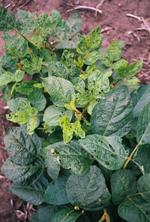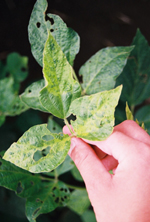Bean pod mottle virus (BPMV) (Genus: Comovirus; Family: Comoviridae) was first identified as a pathogen of snapbeans in 1948. Shortly thereafter, it was identified from infected soybean in Arkansas. The virus is composed of two genomic RNA strands that are enclosed in separate spherical particles. BPMV is primarily transmitted from plant to plant in soybean fields by its vector, the bean leaf beetle (Ceratoma trifurcata). BPMV causes mosaic and distortion of soybean leaves (Figures 1 and 2), reduction in plant height and size (stunting), mottling of the soybean pods, reduction in yields, and discoloration of the soybean seed. In the southern United States, BPMV has affected soybean crops for many years. Why would a pathogen that is a well-established problem become a new concern?

Figure 1 |
|

Figure 2 |
Soybean production in the United States has expanded greatly over the past 35 years. It has also moved northward into the Midwestern states due to increasing demand for soybeans and the release of early maturity soybean cultivars. Soybeans grown in this region were not affected by many of the viral diseases that occurred in the Southern states. Beginning in the late 1990s, Midwestern soybean producers began to observe soybean plants with mosaic and distortion. Discoloration of soybean seed was also reported. Soon, BPMV was identified from soybean plants grown in Illinois, Iowa, Kansas, Nebraska, Ohio, South Dakota, and Wisconsin. High incidences of BPMV within individual producer's fields demonstrated the seriousness of this problem. How had BPMV moved into these new areas?
Researchers quickly observed abundant bean leaf beetles in affected fields. Bean leaf beetle populations that had traditionally been low or absent from the Midwest had now reached high populations over most of the region. Clearly, the beetles required to spread BPMV during the soybean-growing season were present and actively transmitting the virus. However, other questions still remain unsolved. Had the beetles reached these high population numbers due to a series of mild winters, or had the beetles adapted to colder climates as they moved northward? How had the primary inoculum for BPMV moved into the Midwest? These questions continue to be debated among scientists working in this area. However, the clear threat to soybean production caused by the expansion of BPMV into the Midwest is not debatable.
Following the identification of BPMV, other soybean viruses such as soybean mosaic virus (SMV), tobacco ringspot virus (TRSV), tobacco streak virus (TSV), and alfalfa mosaic virus (AMV) were also been identified from areas of the Midwest focusing the attention of plant pathologists on these diseases. Later this month (February 15-19), soybean plant pathologists working with viral and other diseases of soybean in the Midwest and South will meet with soybean breeders in Saint Louis, MO to discuss the latest in soybean research. Meetings such as these provide researchers with opportunities to learn about other researcher's work and to discuss joint research problems and opportunities. As such, they are an integral part of developing solutions to disease management problems, such as this BPMV outbreak.
More information about soybean disease research in the Midwest can be found at the Soybean Plant Health Initiative website (http://www.planthealth.info/index.htm) sponsored by the North Central Soybean Research Program.
